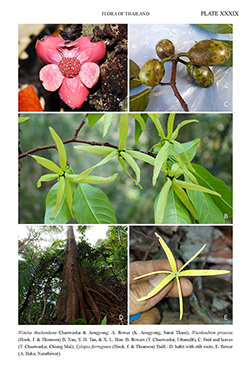e-Flora of Thailand
Volume 16 > Part 1 > Year 2022 > Page 325 > Annonaceae > Xylopia
1. Xylopia ferruginea (Hook.f. & Thomson) Baill.wfo-0000428846
Hist. Pl. 1: 225. 1868; King, J. Asiat. Soc. Bengal, Pt. 2, Nat. Hist. 61: 120. 1892, Ann. Roy. Bot. Gard., Calcutta 4: 151, pl. 198. 1893; J.Sinclair, Gard. Bull. Singapore 14: 343. 1955; I.M.Turner et al. in Soepadmo et al., eds., Tree Fl. Sabah & Sarawak 8: 193. 2014; I.M.Turner, Gard. Bull. Singapore 70: 724. 2018.— Habzelia ferruginea Hook.f. & Thomson, Fl. Ind. 123. 1855.— Melodorum ferrugineum (Hook.f. & Thomson) Finet & Gagnep., Bull. Soc. Bot. France 53, Mém. 4: 138. 1906. Plate XXXIX: D–E.
Accepted Name : This is currently accepted.
Synonyms & Citations :
Description : Tree to 35 m tall; base of trunk with buttresses and stilt roots, bark rough, bright orange-brown. Twigs dark rusty-pubescent, at length glabrate. Leaves chartaceous, elliptic, oblong-elliptic, or oblong-oblanceolate, 9.2–20.7 by 2.3–6.6 cm, base broadly cuneate, rounded, or truncate, apex acute or acuminate, the acumen 1.5–15 mm long, glabrous above, erect-pubescent below, secondary veins 11–17 per side; petioles 3–7 mm long. Inflorescences 1–6-flowered, dark rusty-pubescent, peduncle 2–7.5 mm long, pedicels 6–19 mm long, bract 1, attached just proximal to pedicel midpoint; buds linear-lanceolate, often falciform. Sepals connate at base, narrowly triangular, 3–5.5 mm long, acuminate to caudate, apex often recurved, dark rusty-pubescent outside. Petals greenish yellow, pale yellow, or occasionally orange, sometimes marked with dark purple on the inside of the inner petal base; outer petals linear, 31–60 by 3–4.5 mm at base, apex obtuse, densely pubescent inside, sericeous outside; inner petals linear, 27–34 by 1–2.5 mm at base, apex acute, densely pubescent on both surfaces. Stamens 1.5–2.5 mm long, anther connective apex tongue-shaped. Carpels 18–20. Receptacle flat, with an inconspicous ring surrounding the ovaries. Fruit of up to 22 monocarps borne on a pedicel up to 23 mm long. Monocarps with red exocarp and red endocarp, narrowly cylindrical, torulose, terete in cross-section, 6–11.5 by 0.4–0.6 cm, slightly wrinkled, glabrate, apex rostrate, beak 1–8 mm long, base contracted into a stipe 7–14 mm long. Seeds in a single row, up to 13 per monocarp, oblongoid to ellipsoid, 5–7 by 3–4.6 mm, wrinkled, sarcotesta light bluish to grey, aril absent.
Thailand : PENINSULAR: Nakhon Si Thammarat, Trang, Narathiwat.
Distribution : Peninsular Malaysia (type), Singapore, Sumatra, Borneo.
Ecology : Evergreen forests, and also peat swamp forests with lum pi palm (Eleiodoxa conferta), 0–600 m alt. Although rare in Thailand, Xylopia ferruginea is common in Peninsular Malaysia, where it sometimes occurs in disturbed and secondary growth forests. Flowering: March, April; fruiting: April, October.
Vernacular : Thurian nok (ทุเรียนนก)(Trang).
Notes: The species is easily identified by its stilt roots, large leaves, rusty hairs, and narrowly cylindrical torulose fruits. The young twigs form a zigzag pattern and are frequently marked with decurrent ridges from the petiole bases. The leaves are sometimes glaucous below.

